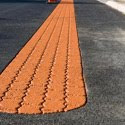 |
| University Street buffered bike lane, in effect |
Enjoy a little breathing room with your bike lane? How about a 2-3 foot buffer? Salt Lake City currently has buffered bike lanes on 2300 East, University Street, 1300 East, and 700 East (adjacent to Liberty Park), and plans to install new buffered lanes this summer. The Division of Transportation is looking for comments on the existing lanes (send comments to
bikeslc@slcgov.com, or just comment on this post). The main question: have you seen cars driving in these wider bike lanes?
New buffered lanes are planned for 900 South (between 900 East and 1100 East) and 1300 East (between 500 South and 600 South). The map below shows locations of existing and planned lanes (existing in blue, planned in red).
 |
| Buffered bike lanes: existing in blue, planned in red. |
Buffered bike lanes provide extra space on one or both sides of a standard bike lane, helping to separate cyclists from traffic, parked cars, or both. Salt Lake City currently has two types: buffers on both sides (2300 East, pictured below), or buffers between the lane and parked cars (such as the lane on University Street) to reduce the chance of getting doored.
 |
| Double-buffered bike lane on 2300 East, between Parley's Canyon Blvd. and Parley's Way |
 |
| University Street, with a buffer between parking and the bike lane |
The lanes planned for this summer have a different design, separating bikes from traffic with a 2-3 foot buffer on the outside of the bike lane, similar to the design from Austin, TX shown below, but with less paint. This format is in the works for 900 South and 1300 East heading north toward the University of Utah. These stretches of street currently lack bike lanes of any type, but may soon have eleven foot-wide dedicated bike facilities. In finalizing the design for these new lanes, the SLC Division of Transportation is asking if locals have encountered cars driving in the existing lanes, and whether the current design has been effective.
 |
| Wide buffer between the bike lane and traffic (source: NACTO) |
Cities across the U.S. are installing a variety of these lanes, aiming to improve safety and encourage new cyclists on the streets. According to a
report by researchers at Portland State University, bicycle counts increased up to 271% on streets in Portland that with new buffered lanes, with 9 in 10 cyclists preferring the buffered lane over a standard bike lane.
The study uncovered a few issues with the lanes, including a slight increase in motor vehicle delay, and poor understanding of when motor vehicles can be in the buffered bike lane. At least one lane
stirred up controversey, but remains in action after the Portland Bureau of Transportation showed improved safety following installation of the lane.
Which U.S. cities are installing them? Austin, TX; Brooklyn, NY; Cape Coral, FL; Marin County, CA; New York, NY; Portland, OR; San Francisco, CA; Seattle, WA; Tucson, AZ. Specific examples include
Stark Street and Southwest Oak in Portland. Notable innovations include rumble strips, textured pavement, and rubber obstacles, such as those in Barcelona, shown below.
 |
| Rubber obstacles in Barcelona (source: copenhagenize) |
 |
| Textured pavement (source: NACTO) |
Another popular design uses parked cars to create separation from traffic. This strategy has been used in Europe and across North America, from Portland to New York City to Montreal (shown below).
 |
| Parking buffered bike lane in Montreal (source: streetsblog) |
In the long-run, these lanes could move Salt Lake City toward additional separated bike facilities, such as cycle tracks.










good stuff! I think they're a good intermediary step before reaching a network of grade-separated bikeways in the future.
ReplyDelete